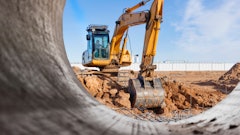When the Minnesota Department of Transportation announced the first joint transportation project to be funded by ARRA stimulus in February, Freeborn County's Hwy. 46 near Albert Lea and MnDOT's I-90, which runs parallel to the county highway in same area, would soon be moved to the front burner in a long list of state projects that would otherwise be delayed or executed in phases over several years.
MnDOT's projects included a 12-mile resurfacing of I-90 from the west limits of Alden to Hwy. 13 near Albert Lea, and Freeborn County's project consisted of a concrete overlay of Hwy. 46 from Arena Road in Albert Lea to Alden.
Because the two projects were located so close to one another, county and state officials decided to submit them as a joint project to take advantage of the economies of scale and to minimize disruption to the traveling public.
Total estimate for the joint project was $17.6 million, with Ulland Brothers of Albert Lea winning the primary contractor bid of just under $16 million. Submitting the two projects as a joint project did help the county and state road agencies enhance their abilities to secure stimulus funding for the two, considering the numerous projects that applied for Minnesota's portion of the ARRA $27.5 billion road and bridge fund.
The joint project is one of nearly 100 Minnesota road and bridge projects that will be funded with $502 million in federal economic stimulus dollars. If the joint project had not been selected to receive stimulus funding, the I-90 portion would not have been completed until 2011. The funding also allowed Freeborn County to advance several other projects to this year's construction season.
I-90 project details
The I-90 portion of the joint project was constructed in two phases. During the first phase of the project, the two eastbound lanes of the interstate were resurfaced with a concrete overlay.
Ulland crews placed 12,000 tons of a permeable asphalt stabilized stress relief course (PASSRC) over the existing concrete roadway before a new concrete surface course was placed.
The PASSRC mix design not only provides drainage underneath the concrete overlay, but it also serves as a bond breaker between the old roadway and the new overlay.
During the second phase of the project, Ulland paving crews placed three 1.5-inch lifts of Superpave (SPWEB440E) hot mix asphalt over the existing concrete westbound lanes.
On the westbound lanes, the original concrete under bridge structures had to be milled out to accommodate the new thickness of the asphalt overlay. It was also necessary to remove any unstable chunks of concrete and replace it with bituminous mix.
The construction specifications also called for correcting the slope on the travel lanes from 1.5% to 2% to improve drainage. This was done with the first leveling course where in some areas, especially along the curves, five to six inches were required along the inside shoulder to obtain the corrected slope specifications.
On the 10-foot-wide outside shoulder, Ulland performed a full-depth reclamation of the asphalt and base aggregate before placing a 3.5-inch Superpave (SPWEB230B) overlay.
Ulland performed all the concrete and blacktop removals required for the project, along with subcutting and grading of all adjacent ditches. The contractor also placed select granular Class 5 base, Class 5 shoulder and blacktop in subcuts for the project.
Ulland has been an industry leader in highway and airport building and repair for over 70 years. The project was supplied with HMA produced at the company's Glenville asphalt plant, a high-production Gencor facility equipped with four silos and a load-out system that allows for multiple mix design production and fast loading for Ulland crews and outside customers.
Extra details
For Ulland's Jeff Carlson, general manager of the Albert Lea division, and Andy Erichson, project manager, the joint I-90/Hwy. 46 project was typical of most asphalt projects with the exception of a few additional requirements outlined by the stimulus program.
"We had to meet ?on-the-job' training requirements of the stimulus program and document 4,000 hours of training," notes Carlson. "We brought on three new people who had no prior experience in asphalt construction and trained them. Two were laborers and eventually equipment operators, and the third was trained in our lab as a Quality Control technician. The project didn't necessarily create a lot of new jobs, but it did save 20 to 30 jobs."
Without the stimulus funds, the I-90 project would have been completed over a two-year period.
"MnDOT would have scheduled only one direction of the project per year with a normal budget funding process, and this section of I-90 may not have been completed for several years," Carlson says. "So it definitely helped our company (Ulland's Southern Division) keep workers on the payroll this year."
Ulland's Albert Lea asphalt production operation supports two paving crews, with 95% of production capacity used on Ulland projects. The westbound lanes required over 50,000 tons of hot mix to overlay 9.8 miles of two main travel lanes.
When asked why the eastbound lanes were constructed with a concrete overlay, Tom Meath, MnDOT District 6 Materials Engineer, explains that there's flexibility in how to execute a rehabilitation project. MnDOT addresses severe road condition issues and heavy truck traffic usage. This particular section of I-90 had some structural issues and a traffic volume of 6.5 to 7 million Equivalent Single Axle Loads (ESAL).
Budget limitations prevented MnDOT from using the concrete overlay on the westbound lanes. It was determined three lifts of Superpave Traffic Level 4 HMA with a PG 64-28 binder would provide an acceptable solution.
"We were allowed to use up to 30% reclaimed asphalt pavement (RAP) in the mix designed produced for the project and we've been maintaining approximately 25% to 30% RAP in the mix we're supplying on the project," Carlson says.
"The inside shoulder is paved in the same operation with the inside travel lane. We are able to break our paver at the edge of the travel lane (12-feet wide) and place the 4-foot shoulder at the required 4% slope," he continues.
"The 10-foot outside shoulder is a different mix and that's being done in a separate pass after the full reclamation of the old shoulder pavement and base aggregate is done. That portion receives a 3 1/2-inch overlay."
As with other MnDOT projects, Ulland had to achieve density and ride smoothness requirements on the I-90 westbound travel lanes. The mix used for the three lifts was designed for 7.9 million ESALs. The first lift required density of 91% and subsequent second (binder) and third (wearing course) had to be compacted to 92%. Ride smoothness specifications had to meet those outlined by the International Roughness Index.
"We're hitting our density numbers and we expect to achieve required smoothness specifications with the final lift," Carlson says. "We hope to pick up several thousand dollars in incentives upon completing the project in late October. We're also saving money with the high RAP content we're allowed to use on the project and that's good for MnDOT as well as us.
"It's been nice to work on a project of this size so close to our location," Carlson adds. "The stimulus funding definitely allowed MnDOT and Freeborn County to do more this year than what they would have and that's been good for our business."


![Hcm Ax Landcros Dual Branded Logo[25]](https://img.forconstructionpros.com/mindful/acbm/workspaces/default/uploads/2025/11/hcmaxlandcros-dual-branded-logo25.Qhg3vUCjoK.jpg?auto=format%2Ccompress&bg=fff&fill-color=fff&fit=fill&h=100&q=70&w=100)



![Hcm Ax Landcros Dual Branded Logo[25]](https://img.forconstructionpros.com/mindful/acbm/workspaces/default/uploads/2025/11/hcmaxlandcros-dual-branded-logo25.Qhg3vUCjoK.jpg?ar=16%3A9&auto=format%2Ccompress&bg=fff&fill-color=fff&fit=fill&h=135&q=70&w=240)









![Fcp Racatac Chair 10893876[1]](https://img.forconstructionpros.com/mindful/acbm/workspaces/default/uploads/2025/10/fcp-racatac-chair-108938761.10l0At5WXv.png?ar=16%3A9&auto=format%2Ccompress&bg=fff&fill-color=fff&fit=fill&h=135&q=70&w=240)